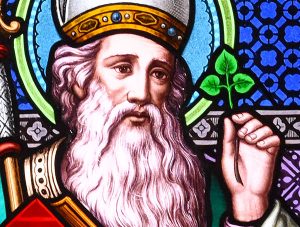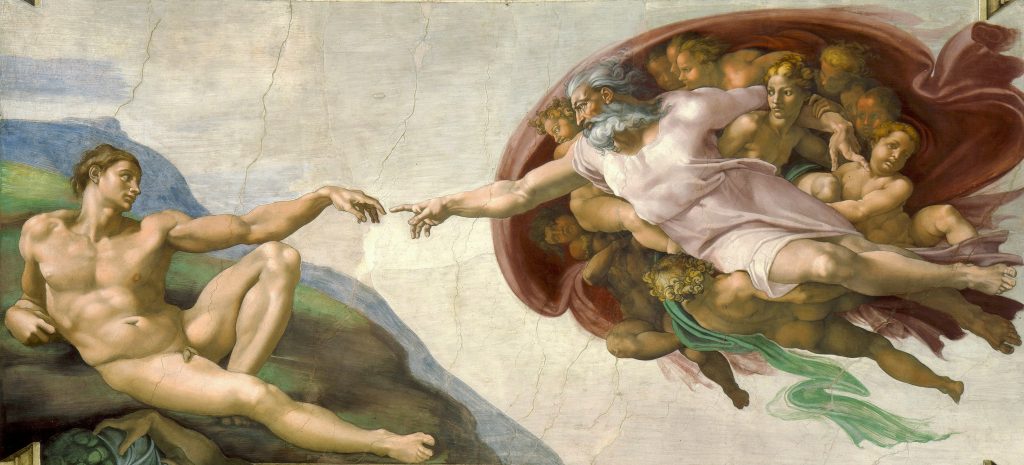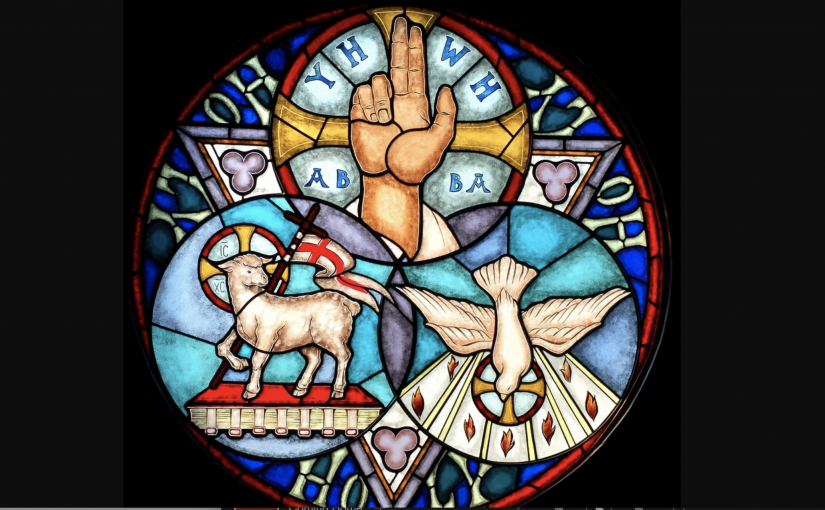A homily for the Solemnity of the Most Holy Trinity, June 7, 2020
Ex 34:4b-6, 8-9, 2 Cor 13:11-13, Jn 3:16-18
We bless ourselves in the name of the Father, and of the Son, and of the Holy Spirit.
And then we lock it in with a solid “Amen.” “It is so.” “Truly.”
We baptize this way. Confirm this way. The Trinitarian way.
Together (yet in the latest translation individually), we declare:
I believe in one God, the Father almighty, maker of heaven and earth, of all things visible and invisible.
I believe in one Lord Jesus Christ, the Only Begotten Son of God, born of the Father before all ages. …
I believe in the Holy Spirit, the Lord, the giver of life, who proceeds from the Father and the Son, who with the Father and the Son is adored and glorified, who has spoken through the prophets.
Three persons in one God: Father, Son and Holy Spirit. Triune. O Most Holy Trinity, undivided unity.
Not three different people; not three different workers, though we do recognize each person’s role as Creator, Redeemer and Sanctifier.
Three persons in one God. One God, three persons.
We accept this as capital-T Truth. It’s the core of our faith. We probably take it a bit for granted, rattling off our various prayers, because of this truth’s profound complexity despite its seeming simplicity.
Occasionally we try to wrap our heads around this mystery, and when we do, we remind ourselves that scholars whose main job is to wrap their heads around mysteries have been thinking and writing for 2,000 years and inevitably end up in the same place: Yup. It’s a mystery.

We credit St. Patrick’s example of the shamrock as an embraceable simplification of the great — and sometimes thorny — notion of a Triune God. And as the legends go, the shamrock and the banishment of the snakes went a long way toward converting the Celts.
But we can go deeper — a little deeper, anyway — when we look at the ultimate nature of the ultimate reality who is our God.
God is love, pure and simple. The purest love there is.
God is good, entirely good, and God’s ways are entirely good, even when — especially when — we don’t understand them or completely agree with them.
God manifests her loving goodness through mercy and forgiveness, through continual creation, via the light that leads us through the darkness of sin on our pilgrim journey back to mercy and forgiveness.
As we hear in today’s Gospel from St. John — the ever-familiar “John Three-Sixteen” — “God so loved the world that he gave his only Son, so that everyone who believes in him might not perish but might have eternal life.”
Father. Son. Holy Spirit.
One Being, expressed as a loving relationship.
We know about relationships, and I hope they’re good ones, beautiful ones. So what we know about relationships can make thinking about the Trinity a bit more accessible. Way more accessible as a concept than shamrocks.
The Father was first, but not in a linear-time sense, because the begotten Son exists as eternally as the Father. And from the love between them, from the love within their relationship, proceeds the Holy Spirit — though, again, the Spirit is as eternally always-was, always-will-be as the Father and Son.
OK, enough metaphysics. Back to John Three-Sixteen.
God so loved the world. Love. It’s the essence of God and it’s the foundation of beautiful relationships. And God wants to have a beautiful, two-way relationship with us, a mature relationship forged through the ministry, death on the cross and resurrection of Jesus the Christ.
Now, without a doubt, God has had a relationship with humanity since the sixth day of Creation, but as the Hebrew Scriptures chronicle, it could be a bit contentious. The blossoming of our relationship with God, the maturing of that relationship, that covenant, that testament is Christ.
God so loved the world that the Son became the man Jesus of Nazareth while remaining God. In embracing human form, Jesus put a relatable face on the infinity that is God’s substance. And as he walked the earth with callused feet, tired, occasionally hungry and thirsty like any other man, Jesus invited all of humanity, those living in the First Century and those yet to be born, into an intimate relationship with our Triune God.
Did you hear the key word there? Invited. A vibrant relationship involves the acceptance of an invitation to share something among the members of that relationship, followed by active and continuing participation.

Michelangelo called his masterwork “The Creation of Adam,” but if you look not only at the hands about to touch but also at their interlocking gazes, you’ll see the forging of a relationship, an eternal bond between God and God’s children. For God, it wasn’t enough to plunk humankind on the Earth and say, “Here ya go. Best of luck.” God said, “Here’s the world I created for you out of love. Do the best you can with it. I’ll be here to back you up. Just call and I’ll answer.”
Are we calling?
Do we call our Heavenly Father the same way we call our earthly parents — every Sunday for a few minutes, just to check in — or do we speak daily? Do we dedicate our days and our work and our good deeds to God, and thus communicate constantly?
God gave us the ability to choose. And through an active, mature relationship, God gives us the tools to help us choose wisely: ongoing creation, salvation through Jesus Christ, a flood of grace through the Holy Spirit.
All good relationships are built on love.
Our Triune God is love.

Cousin Bill,
Beautifully expressed. Bless you & hope to see you soon.
💕 ☮️ Joy
Cousin Jean